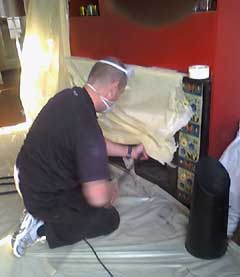 Chimney Flue
Chimney Flue
A chimney flue is the pipe which leads the smoke and noxious gases towards the outside and in turn drawing in air from the bottom thereby supplying oxygen to the fire and keeping it going.
The chimney flue is often referred to as the chimney pipe as it can indeed function alone.
Controlling the airflow in a chimney flue.
The airflow in a chimney flue is controlled with a damper. The damper is a vent on the flue which, when opened allows air to circulate and aids in feed the fire. When a fire is being built it is best to have the damper wide open allowing a generous flow of air through the chimney flue. As the fire burns and becomes more established the damper can be closed gradually until it is shut completely. The chimney flue will by now have heated sufficiently that the process of drawing in air at the bottom and expelling smoke through the top will continue through convection.
Chimney flues through the ages
Though generally made from metal, the flue pipes in many of the older chimney flues were indeed made from tiles, however they would eventually fall off or crack and break as a result of repeated heated and cooling, and often the cracks would form 'hot-spots' resulting in chimney fires. The advent of metal flue pipes brought about a decrease in chimney fires as a result of 'hot-spots'.
In larger homes where there are more than one fireplace the all the chimney flues all angled in the same direction allowing all the smoke to be expelled at one point rather than have a roof full of chimney pots.
Things to consider when installing your chimney flue
- The route of the chimney. A straighter chimney will serve you better
- The difference in air pressure between the actual fire and the top of the chimney.
- The quality of insulation along the length of the chimney.
- The size of the flue as compared to the actual fireplace.
- Access for chimney inspection and cleaning.
Different types of chimney flues
Clay Flues: These are the most common, as well as the most affordable. Clay flues are best used with open fireplace chimneys. They can’t be used with gas fireplaces though.
Metal flues: These can come in either stainless steel, or aluminium. Stainless steel flues are used with wood, gar, or oil fireplaces. Aluminium flues are used only with certain types of gas fireplaces.
Concrete flues: These flues are formed by heat-resistant concrete, poured into the interior of the chimney. This makes them much more permanent than the clay and metal alternatives, as they cannot be removed without replacing the entire chimney. They tend to be pricier in comparison to clay and metal flues, but they are more resilient.